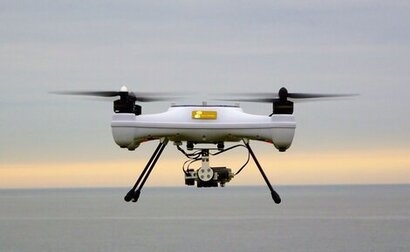
The project, led by scientists from the University of the Highlands and Islands, will use drones to film the movement of water then apply algorithms to determine its speed. It is hoped the technique could provide a simple, effective way to identify locations for underwater tidal turbines which will reduce costs for renewable energy developers and generate opportunities for developing countries. Current methods for measuring tidal streams rely on using survey vessels or installing seabed sensors which can be time consuming and expensive.
Dr Benjamin Williamson, a scientist at North Highlands College UHI’s Environmental Research Institute in Thurso, is leading the 12-month project along with colleagues from Swansea University and Bangor University in Wales. The team will run tests in the Pentland Firth in Scotland and the Ramsey Sound in Wales in various weather conditions.
“Measuring the flow speed and movement of water is vital for developing offshore renewable energy” said Dr Williamson. “These measurements are needed to predict the performance and inform the placement of underwater tidal stream turbines or to optimise the moorings and design of floating turbines. However, gathering these measurements is typically high-cost and high-risk. Our aerial technique offers a cost-effective way to support environmentally-sustainable development of marine renewable energy. It could be used in remote locations and developing countries where suitable survey vessels may not be available or to support community-based approaches to renewable energy generation. We hope to help address the climate emergency by advancing our ability to generate reliable, clean energy.”
Dr Iain Fairley, from Swansea University, added that the work builds upon previous tool development in the EU funded Selkie project and that the project will provide comprehensive validation of drone-based surface current measurements and, importantly, provide a relationship between surface currents and currents at the depths where turbines will be installed. This is crucial to provide developers with the confidence to utilise this cutting-edge tool.
Dr Jared Wilson, Renewables and Energy Programme Manager at Marine Scotland Science, confirmed that the Scottish Government is pleased to be supporting the project and that Marine Scotland Science is looking forward to helping develop the technology.
The ‘validating surface currents at offshore renewable energy sites’ (V-SCORES) project is being funded by the Supergen Offshore Renewable Energy Hub, a £9 million Engineering and Physical Sciences Research Council project led by the University of Plymouth.
For additional information:

